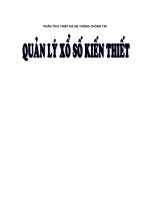Hệ thống thông tin quản lý thi giữa kì
Bạn đang xem bản rút gọn của tài liệu. Xem và tải ngay bản đầy đủ của tài liệu tại đây (47.13 KB, 5 trang )
MIDTERM EXAMINATION
I.
Multiple Choice: (5 marks)
1. Which of the following statements regarding business processes is correct?
a. Business processes represent the series of discrete activities that
something of value to external customers.
b. Business processes represent the series of discrete activities that
something of value to both internal and external customers.
c. Business processes represent the series of interlocking activities that
something of value to both internal and external customers.
d. Business processes represent the series of interlocking activities that
something of value to internal customers.
deliver
deliver
deliver
deliver
2. Which of the following statement is incorrect?
a. The process map presents an ungrouped view of the process
b. Preparing a logical DFD requires grouping the entities
c. Preparing a physical DFD requires grouping the processes
d. None of the above
3. Which of the following statements regarding a database is incorrect?
a. Database systems consist of computer software and hardware.
b. Database systems are mainly used to store data.
c. A carefully thought-of database system need not undergo normalisation.
d. All of the above.
4. Which of the following statement regarding system mapping and documentation is
correct?
a. Systems documentation is crucial for systems development and systems review.
b. Systems documentation serves as a memory device for an organisation.
c. Systems documentation is useful for new staff and external auditors.
d. All of the above.
5. Which of the following statements regarding enterprise information systems is correct?
a. Organisations looking for technology to support their accounting operations
have no choice but to adopt an ERP system, such as People Soft or SAP.
b. A framework for making decisions on which technology to adopt does not exist.
c. ERP systems are not suitable for organisations that are business process
oriented.
d. To decide which technology to adopt, the needs and the future direction of the
organisation must be considered.
6. Which of the following is NOT a benefit of adopting a business process perspective
within the organisation?
a. Better customer service and customer relations.
b. Greater efficiency and effectiveness in using resources.
c. Tighter organisational control.
d. Less non-value-adding activities.
7. Which of the following statements is NOT true about a reengineered process?
a. Jobs change and people are empowered.
b. Work units change from a functional to a process perspective.
c. Controls are increased to ensure smooth functioning.
d. Workers' jobs are combined and workers are given decision rights.
8. Which of the following is NOT a result of moving to a business process-based
environment?
a. The way that the organisation is managed is changed.
b. Functional barriers are broken down.
c. The layer of middle management is thickened.
d. Employee resistance.
9. Which of the following statements is true?
a. Process maps and systems flowcharts can be used to examine segregation of
duties.
b. Logical DFD and context diagrams can be used to examine segregation of
duties.
c. Physical DFD and context diagrams can be used to examine segregation of
duties.
d. None of the above.
10. A typical structured narrative table contains descriptions for:
a. Entities, inputs, processes, and outputs
b. Entities, inputs, outputs, and feedbacks
c. Internal entities, external entities, systems, feedbacks
d. All of the above
II.
True/False and explanation: (5 marks)
1. In modern organisations, accounting is considered as one of the functions that depend
on the technologies of information system.
Answer: T
2. Because BPR gives employees a greater sense of involvement and control over the
process and it increases the diversity of a job and make the job more interesting,
employees will not reject BPR as a method of business change.
Answer: F
3. Because ERP systems adopt best practices in their design, organisations seldom need
to configure their ERP systems or acquire additional software to support their needs.
Answer: F
Within a function know what they require a system to do, and are consequently best
equipped to develop their own systems — it fails to recognise the realities that
confront the modern organisation. As organisations adopt the business process
perspective, they also require information systems that recognise and are designed
around these realities
4. If the external entities presented in a set of context, logical, and physical diagrams are
the same, then this set of data flow diagrams is balanced.
Answer: F
Diagrams (context, physical
data flow and logical data
flow) with the same
external entities and flows
to and from these external
entities are called balanced
data flow
diagramsdiagrams
Diagrams (context, physical
data flow and logical data
flow) with the same
external entities and flows
to and from these external
entities are called balanced
data flow
diagramsdiagrams
Diagrams (context, physical data flow and logical data flow) with the same external
entities and flows to and from these external entities are called balanced data flow
diagrams
5. As accounting information systems are being computerised, data management will
become less of an issue.
Answer: T
In a computerized environment, audit trails are often not saved, or only saved for a
short time and require computer support.
In a computerized environment, some transactions can be performed automatically
and approvals are not saved on documents









